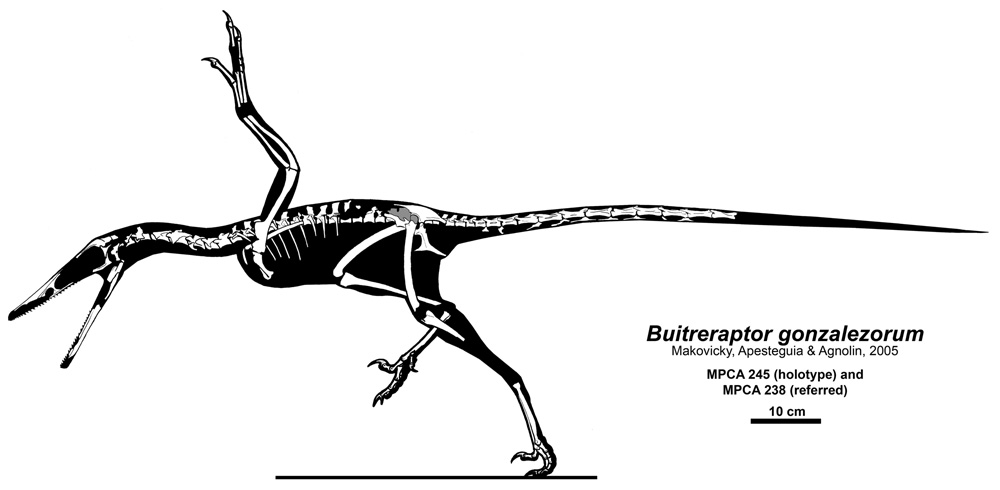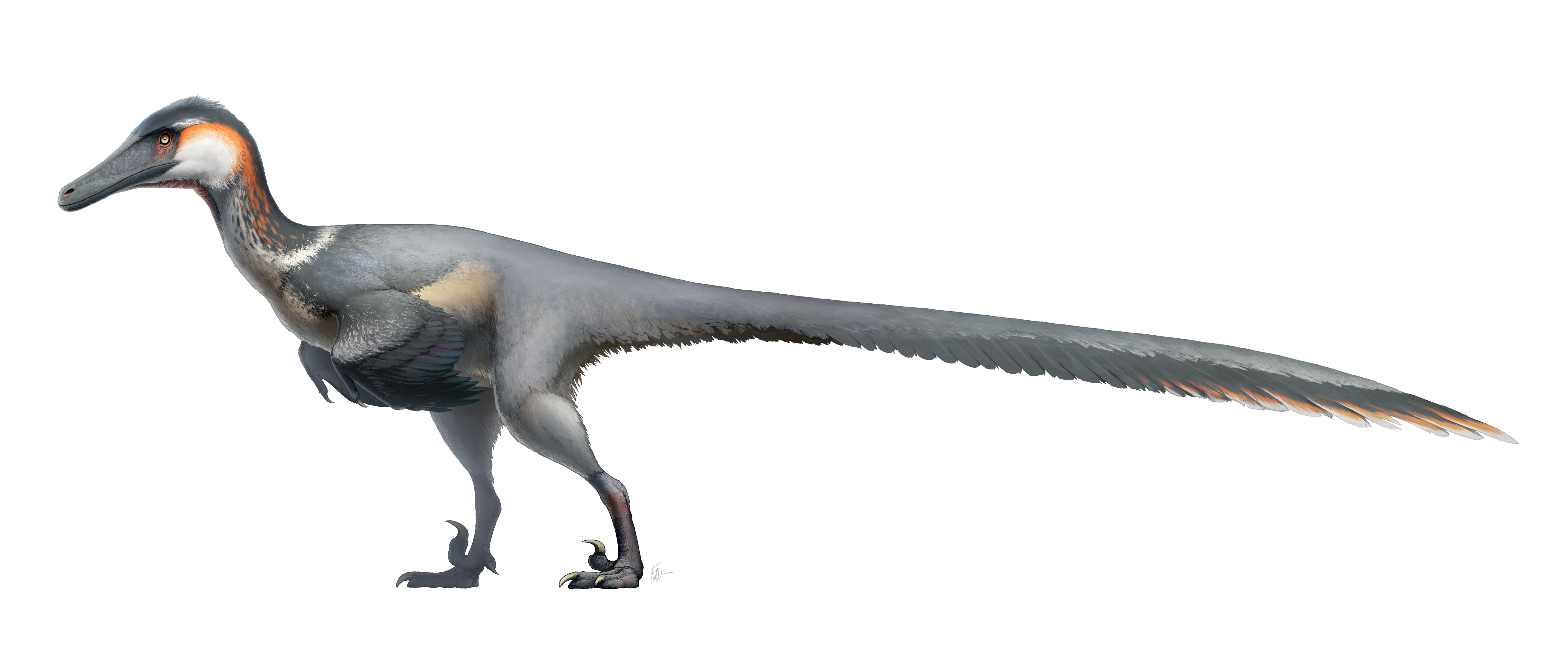|
Unenlagiidae
Unenlagiidae is a proposed family of eumaniraptoran paravians that includes the subfamilies Unenlagiinae and possibly Halszkaraptorinae. Fossils of both subfamilies have been found in both Gondwanan and Laurasian deposits. The biology of the group suggests that some members were semiaquatic specialists. Classification The family Unenlagiidae traditionally includes the same members as the previously named subfamily of Dromaeosauridae, Unenlagiinae, so Unenlagiidae was often seen as a synonym of Dromaeosauridae. However, since the 2010s, there have been subsequent studies that have questioned this placement, necessitating the revival of the family name. Some have placed unenlagiids as outside Dromaeosauridae, being the sister taxon or closely related to Avialae, while others have placed the newly recognized halszkaraptorines in the family, as basal deinonychosaurs outside Dromaeosauridae and Troodontidae Troodontidae is a clade of bird-like theropod dinosaurs from the La ... [...More Info...] [...Related Items...] OR: [Wikipedia] [Google] [Baidu] |
Buitreraptor
''Buitreraptor'' (meaning "La Buitrera seizer") is a genus of dromaeosaurid dinosaurs that lived during the Late Cretaceous of Argentina at the Candeleros Formation. ''Buitreraptor'' was described in 2005 and the type species is ''Buitreraptor gonzalezorum''. It was rooster-sized and had a very elongated head with many small teeth. History of discovery Four specimens of ''Buitreraptor'' were found in 2004 in sandstone in Patagonia, Argentina during an excavation led by Sebastián Apesteguia, researcher of CONICET at the Fundacion Felix de Azara - Maimonides University, and Peter Makovicky, curator of dinosaurs at the Field Museum in Chicago. ''Buitreraptor'' is from the early Late Cretaceous Candeleros Formation, dating to the Cenomanian-Turonian ages approximately 98 to 97 million years ago, when South America was an isolated continent like Australia today. It was uncovered in a famous fossil site named ''La Buitrera'', the "vulture roost". Although dinosaurs are rare in t ... [...More Info...] [...Related Items...] OR: [Wikipedia] [Google] [Baidu] |
Deinonychosauria
Deinonychosauria is a clade of paravian dinosaurs which lived from the Late Jurassic to the Late Cretaceous periods. Fossils have been found across the globe in North America, Europe, Africa, Asia, South America, and Antarctica,Case, J.A., Martin, J.E., and Reguero, M. (2007). "A dromaeosaur from the Maastrichtian of James Ross Island and the Late Cretaceous Antarctic dinosaur fauna." Pp. 1–4 in Cooper, A., Raymond, C., and Team, I.E. (eds.), ''Antarctica: a Keystone in a Changing World – Online Proceedings for the Tenth International Symposium on Antarctic Earth Sciences'', U.S. Geological Survey Open-File Report 2007-1047, SRP 083. U.S. Geological Survey, Washington, D.C. with fossilized teeth giving credence to the possibility that they inhabited Australia as well. This group of dinosaurs are known for their sickle-shaped toe claws and features in the shoulder bones. Deinonychosauria is commonly defined as all dinosaurs more closely related to dromaeosaurids (such as '' D ... [...More Info...] [...Related Items...] OR: [Wikipedia] [Google] [Baidu] |
Avialae
Avialae ("bird wings") is a clade containing the only living dinosaurs, the birds, and their closest relatives. It is usually defined as all theropod dinosaurs more closely related to birds (Aves) than to Deinonychosauria, deinonychosaurs, though alternative definitions are occasionally used (see below). ''Archaeopteryx lithographica'', from the late Jurassic Period Solnhofen Formation of Germany, is usually considered the earliest known avialan which may have had the capability of powered flight; a minority of studies have suggested that it might have been a deinonychosaur instead. Several older (but non flight-capable) possible avialans are known from the late Jurassic Tiaojishan Formation of China, dated to about 160 million years ago. Definition Most researchers define Avialae as branch-based clade, though definitions vary. Many authors have used a definition similar to "all theropods closer to birds than to ''Deinonychus''."Weishampel, David B.; Dodson, Peter; Osmólska, ... [...More Info...] [...Related Items...] OR: [Wikipedia] [Google] [Baidu] |
Archaeopteryx
''Archaeopteryx'' (; ), sometimes referred to by its German name, "" ( ''Primeval Bird'') is a genus of bird-like dinosaurs. The name derives from the ancient Greek (''archaîos''), meaning "ancient", and (''ptéryx''), meaning "feather" or "wing". Between the late 19th century and the early 21st century, ''Archaeopteryx'' was generally accepted by palaeontologists and popular reference books as the oldest known bird (member of the group Avialae). Older potential avialans have since been identified, including ''Anchiornis'', ''Xiaotingia'', '' Aurornis'', and '' Baminornis''. ''Archaeopteryx'' lived in the Late Jurassic around 150 million years ago, in what is now southern Germany, during a time when Europe was an archipelago of islands in a shallow warm tropical sea, much closer to the equator than it is now. Similar in size to a Eurasian magpie, with the largest individuals possibly attaining the size of a raven, the largest species of ''Archaeopteryx'' ... [...More Info...] [...Related Items...] OR: [Wikipedia] [Google] [Baidu] |
Unenlagia
''Unenlagia'' (meaning "half-bird" in Latinized Mapudungun) is a genus of dromaeosaurid theropod dinosaur that lived in South America during the Late Cretaceous period. The genus ''Unenlagia'' has been assigned two species: ''U. comahuensis'', the type species described by Novas and Puerta in 1997, and ''U. paynemili'', described by Calvo ''et al.'' in 2004. Discovery and naming In 1996 in the Neuquén province of Argentina a skeleton of a theropod was discovered in the Sierra del Portezuelo and reported the same year. In 1997 Fernando Emilio Novas and Pablo Puerta named and described ''Unenlagia comahuensis''. The generic name is derived from Mapuche ''uñùm'', 'bird', and ''llag'', 'half', in reference to the fact that the describers considered the species to be a link between birds and more basal theropods. The specific name refers to the Comahue, the region the find was made. The holotype specimen, MCF PVPH 78, was uncovered in layers of the Portezuelo Formation dating ... [...More Info...] [...Related Items...] OR: [Wikipedia] [Google] [Baidu] |
Austroraptor
''Austroraptor'' ( ) is a genus of dromaeosaurid theropod dinosaur that lived during the Campanian and Maastrichtian ages of the Late Cretaceous period in what is now Argentina. ''Austroraptor'' was a large, moderately-built, ground-dwelling, bipedal carnivore, measuring around long and weighing up to . It is one of the largest dromaeosaurids known, with only '' Achillobator'', '' Dakotaraptor'', and '' Utahraptor'' approaching or surpassing it in length. Discovery and naming The type specimen of ''Austroraptor cabazai'', holotype MML-195, was recovered in the Bajo de Santa Rosa locality of the Allen Formation, in Río Negro, Argentina. The specimen was collected in 2002 by the team of Fernando Emilio Novas of the '' Museo Argentino de Ciencias Naturales''. It consists of a fragmentary skeleton including parts of the skull, lower jaw, a few neck and torso vertebrae, some ribs, a humerus, and assorted bones from both legs. The specimen was prepared by Marcelo Pablo Isasi a ... [...More Info...] [...Related Items...] OR: [Wikipedia] [Google] [Baidu] |
Dromaeosauridae
Dromaeosauridae () is a family of feathered coelurosaurian theropod dinosaurs. They were generally small to medium-sized feathered carnivores that flourished in the Cretaceous Period. The name Dromaeosauridae means 'running lizards', from Greek ('), meaning 'running at full speed', 'swift', and ('), meaning 'lizard'. In informal usage, they are often called raptors (after '' Velociraptor''), a term popularized by the film ''Jurassic Park''; several genera include the term "raptor" directly in their name, and popular culture has come to emphasize their bird-like appearance and speculated bird-like behavior. Dromaeosaurid fossils have been found across the globe in North America, Europe, Africa, Asia and South America, with some fossils giving credence to the possibility that they inhabited Australia as well. The earliest body fossils are known from the Early Cretaceous (145–140 million years ago), and they survived until the end of the Cretaceous (Maastrichtian stage, 66 ... [...More Info...] [...Related Items...] OR: [Wikipedia] [Google] [Baidu] |
Paraves
Paraves are a widespread group of theropod dinosaurs that originated in the Middle Jurassic period. In addition to the extinct dromaeosauridae, dromaeosaurids, troodontidae, troodontids, Anchiornithidae, anchiornithids, and possibly the scansoriopterygidae, scansoriopterygids, the group also contains the Avialae, avialans, which include diverse extinct taxa as well as the over 11,000 species of living birds. Basal members of Paraves are well known for the possession of an enlarged claw on the second digit of the foot, which was held off the ground when walking in some species. A number of differing scientific interpretations of the relationships between paravian taxa exist. New fossil discoveries and analyses make the classification of Paraves an active subject of research. Description Like other theropods, all paravians are bipedal, walking on their two hind legs. The teeth of basal paravians were curved and serrated, but not blade-like except in some specialized species, suc ... [...More Info...] [...Related Items...] OR: [Wikipedia] [Google] [Baidu] |
Halszkaraptorinae
Halszkaraptorinae is an extinct basal ("primitive") subfamily of Dromaeosauridae (or possibly Unenlagiidae) that includes the enigmatic genera '' Halszkaraptor'', '' Natovenator'', ''Mahakala'', and '' Hulsanpes''. Halszkaraptorines are definitively known only from Late Cretaceous strata in Asia, specifically in Mongolia. It is debated among researchers whether the group had a semiaquatic lifestyle. History of discovery The first known remains of halszkaraptorines were found in sandstone sediments in 1970 during a Polish-Mongolian expedition at the Barun Goyot Formation, Gobi Desert. Later in 1982, they were described by Polish palaeontologist Halszka Osmólska and used as the holotype for the new genus and species '' Hulsanpes perlei'', honoring the Mongolian paleontologist Altangerel Perle. Although the affinities of these fossils were not fully understood, they were tentatively interpreted as belonging to Deinonychosauria. In 1992 dromaeosaurid-like fossils were recovered ... [...More Info...] [...Related Items...] OR: [Wikipedia] [Google] [Baidu] |
Overoraptor
''Overoraptor'' (, meaning "piebald thief") is an extinct genus of paravian theropod of uncertain affinities from the Late Cretaceous Huincul Formation of Argentinian Patagonia. The genus contains a single species, ''O. chimentoi'', known from several bones of the hands, feet, and hips alongside some vertebrae. Discovery and naming The fossil specimens of ''Overoraptor'' were unearthed by Dr. Roberto Nicolás Chimento in the Violante Farm locality, which is southeast of the Ezequiel Ramos-Mexía lake, in the northwestern portion of Rio Negro Province, Argentina. This outcrop is part of the Huincul Formation, which is dated to the Cenomanian-Turonian boundary in the Cretaceous period. This formation has yielded some of the largest South American dinosaurs including the massive sauropod ''Argentinosaurus'' and the theropod '' Mapusaurus''. The precise date of the discovery of the type series of ''Overoraptor'' is not publicly known, but the specimens were reposited in the ... [...More Info...] [...Related Items...] OR: [Wikipedia] [Google] [Baidu] |
Unenlagiinae
Unenlagiinae is a subfamily of long-snouted paravian theropods. They are traditionally considered to be members of Dromaeosauridae, though some authors place them into their own family, Unenlagiidae, sometimes alongside the subfamily Halszkaraptorinae. Definitive members are known from the Late Cretaceous of South America, though some researchers include taxa from other continents within this subfamily based on phylogenetic analyses. Two probable unenlagiine specimens (NMV P257601, NMV P180889) from the upper Strzelecki Group (Aptian) and Eumeralla Formation (lower Albian) of Australia might potentially extend their known fossil range to the Early Cretaceous, and '' Kakuru,'' which is considered a maniraptoran, and might be an unenlagiine as well. ''Imperobator'' from the Late Cretaceous of Antarctica, previously considered enigmatic, has also been recently interpreted as an unenlagiine. Description Most unenlagiines have been discovered in Argentina. The largest was '' ... [...More Info...] [...Related Items...] OR: [Wikipedia] [Google] [Baidu] |






